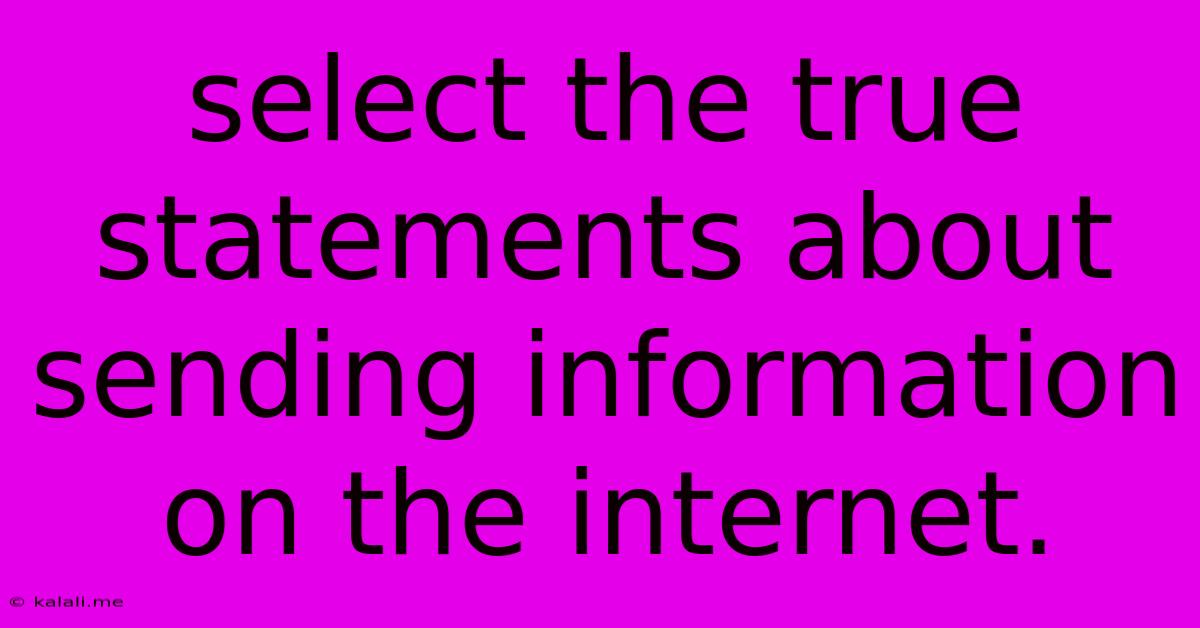Select The True Statements About Sending Information On The Internet.
Kalali
Jun 16, 2025 · 3 min read

Table of Contents
Select the True Statements About Sending Information on the Internet: A Deep Dive
The internet, a vast network connecting billions of devices, relies on intricate processes to transmit information. Understanding how this works is crucial for anyone navigating the digital world, from casual users to seasoned developers. This article clarifies common misconceptions surrounding internet data transmission by identifying true statements about the process. We'll explore the fundamental principles, highlighting key aspects and demystifying the technology behind every click, download, and online interaction.
What Makes Data Transmission on the Internet Possible?
Before diving into true statements, let's briefly touch upon the foundational elements:
-
Data Packets: Information isn't sent as a continuous stream, but broken down into smaller units called packets. This allows for efficient routing and error recovery.
-
IP Addresses: Each device connected to the internet has a unique IP address, acting like a postal code, ensuring data reaches its intended destination.
-
Routers: These act as traffic controllers, directing packets along the most efficient path through the network.
-
Protocols: These are sets of rules that govern how data is formatted, transmitted, and received. Common protocols include TCP/IP (Transmission Control Protocol/Internet Protocol) and HTTP (Hypertext Transfer Protocol).
True Statements About Sending Information on the Internet:
Now, let's identify some true statements about this complex process:
-
Data is sent in packets: As mentioned earlier, this is a fundamental principle. Breaking data into smaller packets allows for more efficient transmission, error correction, and parallel processing. If one packet is lost, others can still arrive, leading to a more robust system.
-
The internet uses a system of interconnected networks: The internet isn't a single, unified network, but a collection of interconnected networks (like the internet service providers' networks) that communicate with each other using standardized protocols. This decentralized architecture contributes to its resilience and scalability.
-
IP addresses are crucial for routing data: Without IP addresses, there would be no way to direct data packets to their correct destination. These addresses uniquely identify devices on the network, enabling efficient routing and delivery.
-
Transmission Control Protocol (TCP) ensures reliable data delivery: TCP provides a connection-oriented service, confirming the successful delivery of each packet. It manages error detection and correction, making it ideal for applications requiring reliable data transfer, like web browsing and file downloads.
-
Different protocols are used for different types of data transmission: HTTP is used for web browsing, SMTP for email, FTP for file transfer, and so on. Each protocol has its own specific set of rules, optimized for its purpose.
-
Data transmission is affected by network congestion: Network congestion occurs when too much data is being transmitted at once, leading to slower speeds and potential delays. This is why peak times often result in slower internet performance. This is a constant factor affecting real-time performance.
-
Security protocols protect data during transmission: Protocols like HTTPS (secure HTTP) use encryption to protect data from eavesdropping and tampering, ensuring secure communication, especially when transmitting sensitive information.
False Statements (To Help You Understand Better):
To solidify your understanding, let's quickly address some common misconceptions:
-
Data is always sent directly between sender and receiver: Data often travels through many routers and networks before reaching its destination.
-
All data transmission is equally fast: Transmission speed depends on several factors, including network congestion, distance, and the bandwidth of the connection.
-
The internet is a single, centralized network: As mentioned, it's a collection of interconnected networks.
Understanding these true and false statements provides a clearer picture of how information travels across the internet. This knowledge is valuable for anyone interacting with this vital global network, empowering you to navigate the digital landscape with greater understanding and confidence.
Latest Posts
Latest Posts
-
How To Create Clickable Image In Html
Jun 16, 2025
-
What Are The Factors Of 121
Jun 16, 2025
-
What Is A Theme Of The Passage
Jun 16, 2025
-
A Company That Provides Access To The Internet
Jun 16, 2025
-
Which Word Is Closest In Meaning To The Underlined Word
Jun 16, 2025
Related Post
Thank you for visiting our website which covers about Select The True Statements About Sending Information On The Internet. . We hope the information provided has been useful to you. Feel free to contact us if you have any questions or need further assistance. See you next time and don't miss to bookmark.